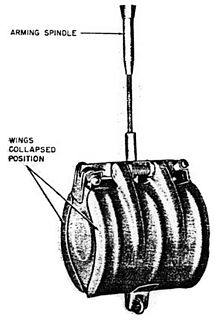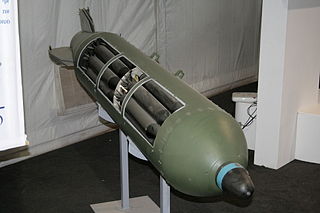Related Research Articles
Mine, mines, miners or mining may refer to:

A cluster munition is a form of air-dropped or ground-launched explosive weapon that releases or ejects smaller submunitions. Commonly, this is a cluster bomb that ejects explosive bomblets that are designed to kill personnel and destroy vehicles. Other cluster munitions are designed to destroy runways or electric power transmission lines, disperse chemical or biological weapons, or to scatter land mines. Some submunition-based weapons can disperse non-munitions, such as leaflets.

The AGM-154 Joint Standoff Weapon (JSOW) is a glide bomb that resulted from a joint venture between the United States Navy and Air Force to deploy a standardized medium range precision guided weapon, especially for engagement of defended targets from outside the range of standard anti-aircraft defenses, thereby increasing aircraft survivability and minimizing friendly losses.

A Butterfly Bomb was a German 2 kilogram anti-personnel submunition used by the Luftwaffe during the Second World War. It was so named because the thin cylindrical metal outer shell which hinged open when the bomblet deployed gave it the superficial appearance of a large butterfly. The design was very distinctive and easy to recognise. SD 2 bomblets were not dropped individually, but were packed into containers holding between 6 and 108 submunitions e.g. the AB 23 SD 2 and AB 250-3 submunition dispensers. The SD 2 submunitions were released after the container was released from the aircraft and had burst open. Because SD 2s were always dropped in groups the discovery of one unexploded SD 2 was a reliable indication that others had been dropped nearby. This bomb type was one of the first cluster bombs ever used in combat and it proved to be a highly effective weapon. The bomb containers that carried the SD 2 bomblets and released them in the air were nicknamed the "Devil's Eggs" by Luftwaffe air and ground crew.

Anti-runway penetration bombs are systems involving bombs or bomblets designed to disrupt the surface of an airfield runway and make it unusable for flight operations.
The CBU-97 Sensor Fuzed Weapon is a United States Air Force 1,000-pound (450 kg)-class freefall Cluster Bomb Unit. It was developed and produced by Textron Defense Systems. The CBU-97 used in conjunction with the Wind Corrected Munitions Dispenser guidance tail kit, is converted to a precision-guided weapon and designated CBU-105.

BL755 is a cluster bomb developed by Hunting Aircraft that contains 147 parachute-retarded high explosive anti-tank (HEAT) submunitions. Its primary targets are armoured vehicles and tanks with secondary soft target capabilities. It entered service with the Royal Air Force (RAF) in 1973.

Originally known as the LAAAS, the JP233 is a British submunition delivery system consisting of large dispenser pods carrying several hundred submunitions designed to attack runways.

The CBU-24 is an unguided, aircraft delivered anti-personnel and anti-materiel weapon developed by the United States. Because it is an unguided weapon, the CBU-24 can be carried and dropped by any aircraft capable of carrying standard "dumb" or "iron" bombs.

A Dual-Purpose Improved Conventional Munition (DPICM) is an artillery or surface-to-surface missile warhead designed to burst into sub-munitions at an optimum altitude and distance from the desired target for dense area coverage. The sub-munitions use both explosively formed penetrators for anti-armor work and fragmentation for antipersonnel work. Some sub-munitions may be designed for delayed reaction or mobility denial (mines). The air-to-surface variety of this kind of munition is better known as a cluster bomb. They are banned by some countries under the Convention on Cluster Munitions.

OGLE-2005-BLG-390L is a star thought to be a spectral type M. This dim magnitude 16 galactic bulge star is located in the Scorpius constellation at a far distance of about 21,500 light years.
The CBU-87 Combined Effects Munition (CEM) is a cluster bomb used by the United States Air Force, developed by Aerojet General/Honeywell and introduced in 1986 to replace the earlier cluster bombs used in the Vietnam War. CBU stands for Cluster Bomb Unit. When the CBU-87 is used in conjunction with the Wind Corrected Munitions Dispenser guidance tail kit, it becomes much more accurate, and is designated CBU-103.

The RRAB-3, nicknamed the Molotov bread basket, was a Soviet-made droppable bomb dispenser that combined a large high-explosive charge with a cluster of incendiary bombs. It was used against the cities of Finland during the Winter War of 1939–1940. The bomb consisted of a cylinder 2.25 metres (7.4 ft) long and 0.9 metres (3.0 ft) in diameter.
The CBU-72 was a 550-pound American fuel-air cluster bomb used by the United States Military until 1996. It was very effective against armored vehicles, aircraft parked in the open, bunkers, and minefields.

The Convention on Cluster Munitions (CCM) is an international treaty that prohibits the use, transfer, and stockpiling of cluster bombs, a type of explosive weapon which scatters submunitions ("bomblets") over an area. The convention was adopted on 30 May 2008 in Dublin, and was opened for signature on 3 December 2008 in Oslo. It entered into force on 1 August 2010, six months after it was ratified by 30 states. As of September 2020, 109 states have signed the treaty and 111 have ratified it or acceded to it.
The E14 munition was a cardboard sub-munition developed by the United States biological weapons program as an anti-crop weapon. In a series of field tests in 1955, the E14 was loaded with fleas and air-dropped.
Ejection charge, also called expelling charge, is a pyrotechnic composition, a type of a pyrotechnic gas generator designed to produce a small short-term amount of thrust to burst open a container and eject its content.

Instalaza SA is a Spanish firm that designs, develops and manufactures equipment and other military material for infantry. The company, founded in 1943, is headquartered in Zaragoza, Aragon, where its production plant is also located, The company became famous for the production of highly accurate rocket launchers.
The MAT-120 cargo bomb is a Spanish-produced cluster munition, fired from a 120mm calibre mortar produced by Instalaza SA. The main body of the round holds dual-purpose anti-tank/anti-personnel submunitions. The MAT-120 submunitions are unique in that to prevent the dangers of unexploded duds, there is a double redundant feature the manufacturer refers to as self-destruction and self-sterilization. This prevents unexploded MAT-120 submunitions from lying around becoming de facto landmines, dangerous to both combatants and non-combatants.
References
- ↑ "Força Aérea Brasileira: BLG-120/204/252 - Bombas Lança-Granadas". freepages.military.rootsweb.ancestry.com (in Spanish). 2006. Retrieved 4 November 2013.
| This article related to weaponry is a stub. You can help Wikipedia by expanding it. |
| This Brazilian military article is a stub. You can help Wikipedia by expanding it. |